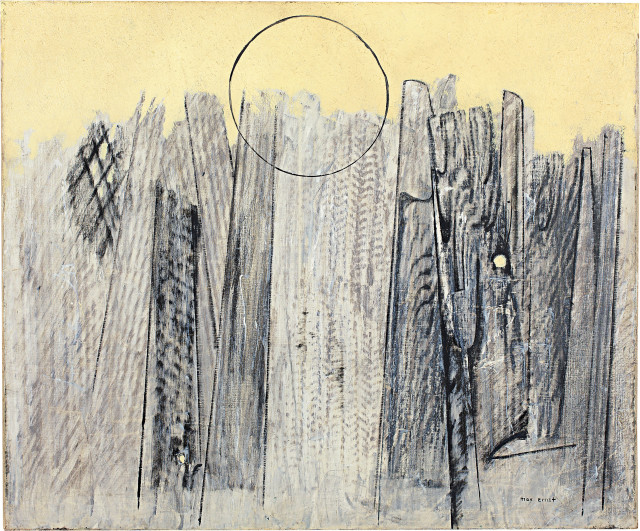- FR
S’inscrire
- Ventes Classiques
- Ventes passées
- Plus
- Acheter
- Vendre
- Plus
- Galerie
- Commerce d'art
- Maison d'Édition
- Kornfeld aujourd’hui
- L'histoire de la Maison
- Informations





Brühl 1891 - 1976 Paris
1925
Oil on canvas
54x65 cm
Signed by the artist in black at lower right "Max Ernst"
Werner Spies/Sigrid and Günter Metken, Max Ernst, Werke 1925-1929, Cologne 1976, no. 930
D'Arcy, Paris
Private collection, Paris
Private collection, Monaco
Sète 2016, Musée Paul Valéry, Max Ernst - Yves Tanguy: Deux Visions du Surréalisme, cat. no. 4, pag. 71 reprod.
On the old stretcher, some retouches at the margins (caused by former framing), single touch-ups. Colour fresh and in very good overall condition
In 1922 Max Ernst left his young family and moved to Paris for good. At first he lived for a long time with Paul Éluard and finally moved into his first studio in 1925 in the artists' colony "Les Fusains" at 22 rue Tourlaque, where Sophie Taeuber and Hans Arp were also working at the time, followed shortly afterwards by Joan Miró. Once, when he was looking closely at the rutted wooden floor in an inn, he put a piece of paper on it and rubbed lead over it. This is how he discovers "frottage", i.e. the transfer of a three-dimensional surface onto a picture support, as a groundbreaking innovation in his oeuvre and in art history. He then lays the prepared canvases on uneven surfaces and applies paint to them with a palette knife so that the relief of the surfaces shines through and a wide variety of patterns emerge. Later, the works are further reworked with palette knife and brush. These different explorations of materials and forms, guided by chance, lead to innovative and unexpected compositions
Always interested in natural phenomena, Ernst has worked on the theme of the forest (Forêt) since the 1920s. With the discovery of frottage, he was offered new possibilities to realise the theme. By "rubbing down" weathered wooden boards, he creates materialised, stylised trees out of wood. Lined up vertically next to each other, they create the illusion of a forest. The painting offered here is one of the earliest Forêt depictions, created in this manner. For the first time in this series he also uses a circle as a metaphorical sun. With the simplest, illusionistic means, the artist creates an impressive composition
For Ernst, the forest was a means of grasping and uniting the inner and outer worlds. The first paintings of the theme, including the one offered here, are still painted in light colours. Later, the artist lends the forest a sombre atmosphere and creates oppressive landscapes that already anticipate his later series of petrified cities.
The "Forêt" offered here is one of the most important works from this group, both compositionally and in terms of the degree of elaboration
1925
Öl auf Leinwand
54x65 cm
Unten rechts vom Künstler in Schwarz signiert "Max Ernst"
Werner Spies/Sigrid und Günter Metken, Max Ernst, Werke 1925-1929, Köln 1976, Nr. 930
D'Arcy, Paris
Privatsammlung, Paris
Privatsammlung, Monaco
Sète 2016, Musée Paul Valéry, Max Ernst - Yves Tanguy: Deux Visions du Surréalisme, Kat. Nr. 4, pag. 71 reprod.
Auf dem alten Chassis, einige Retouchen an den Rändern (durch frühere Rahmungen bedingt), einzelne Ausbesserungen. Farbfrisch und in sehr guter Gesamterhaltung
Im Jahr 1922 verlässt Max Ernst seine junge Familie und zieht endgültig nach Paris. Zuerst wohnt er lange bei Paul Éluard und bezieht schliesslich 1925 sein erstes Atelier in der Künstlerkolonie "Les Fusains" in der rue Tourlaque 22, wo zu dieser Zeit auch Sophie Taeuber und Hans Arp, kurz darauf auch Joan Miró tätig waren. Als er einmal in einem Gasthaus den zerfurchten Holzboden genauer betrachtet, legt er ein Papier darauf und reibt mit Blei darüber. So entdeckt er für sich die "Frottage", also die Übertragung einer dreidimensionalen Oberfläche auf einen Bildträger, als bahnbrechende Innovation in seinem Œuvre und der Kunstgeschichte. Die vorbereiteten Leinwände legt er in der Folge auf unebene Flächen und bestreicht sie mit einem Spachtel mit Farbe, so dass das Relief der Oberflächen durchscheint und die unterschiedlichsten Muster entstehen. Später werden die Werke weiter mit Spachtel und Pinsel überarbeitet. Diese verschiedenen, vom Zufall geleiteten Erkundungen von Materialien und Formen, führen zu innovativen und unerwarteten Kompositionen
Immer schon an Naturphänomenen interessiert, bearbeitet Ernst das Thema Wald (Forêt) seit den 1920er Jahren. Mit der Entdeckung der Frottage, bieten sich ihm neue Möglichkeiten das Thema umzusetzen. Indem er verwitterte Holzbretter "abfrottiert", schafft er aus Holz materialisierte, stilisierte Bäume. Vertikal nebeneinander aufgereiht erwecken sie die Illusion eines Waldes. Das hier angebotene Gemälde ist eine der frühesten Forêt-Darstellungen, in dieser Manier geschaffen. Erstmals setzt er in dieser Serie auch einen Kreis als metaphorische Sonne sein. Mit einfachsten, illusionistischen Mitteln schafft der Künstler eine eindrückliche Komposition
Für Ernst war der Wald ein Mittel, um die innere und die äussere Welt zu erfassen und zu vereinen. Die ersten Gemälde des Themas, so auch das hier angebotene, sind noch in hellen Farben gemalt. Später verleiht der Künstler dem Wald eine düstere Atmosphäre und schafft bedrückende Landschaften, die bereits seine spätere Serie der versteinerten Städte vorwegnehmen
Der hier angebotene "Forêt" gehört kompositorisch und vom Ausarbeitungsgrad her zu den bedeutendsten Arbeiten aus dieser Gruppe






